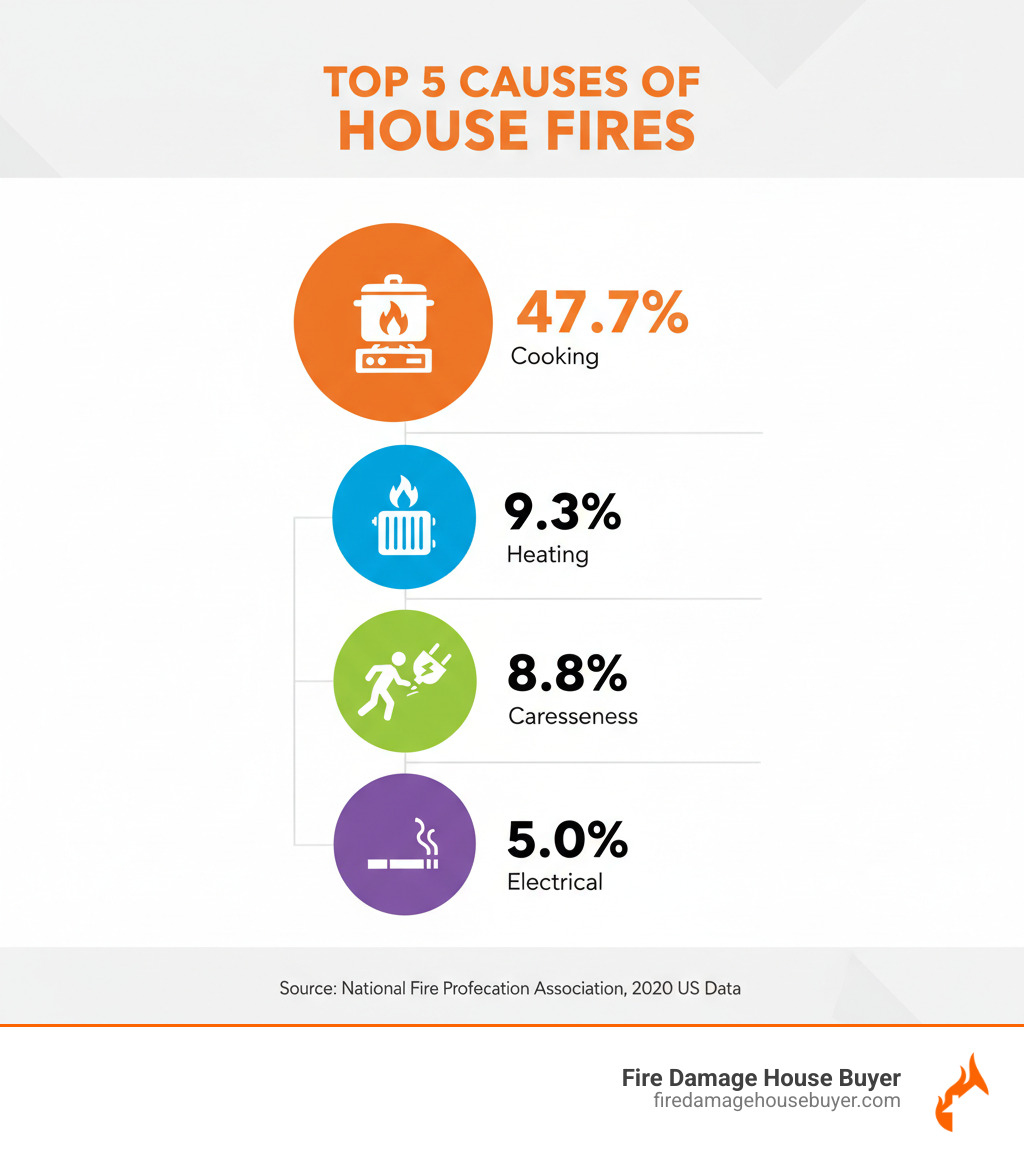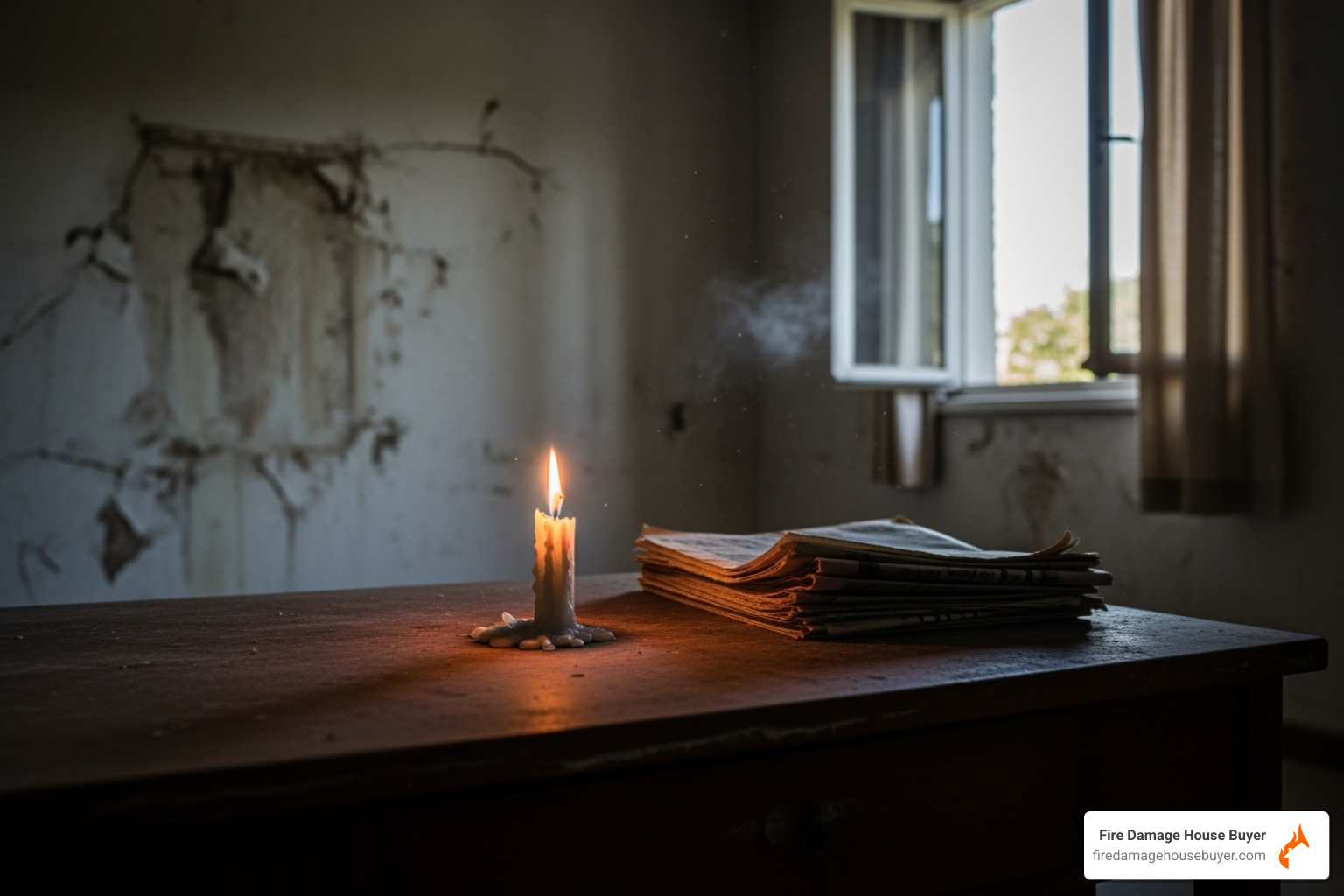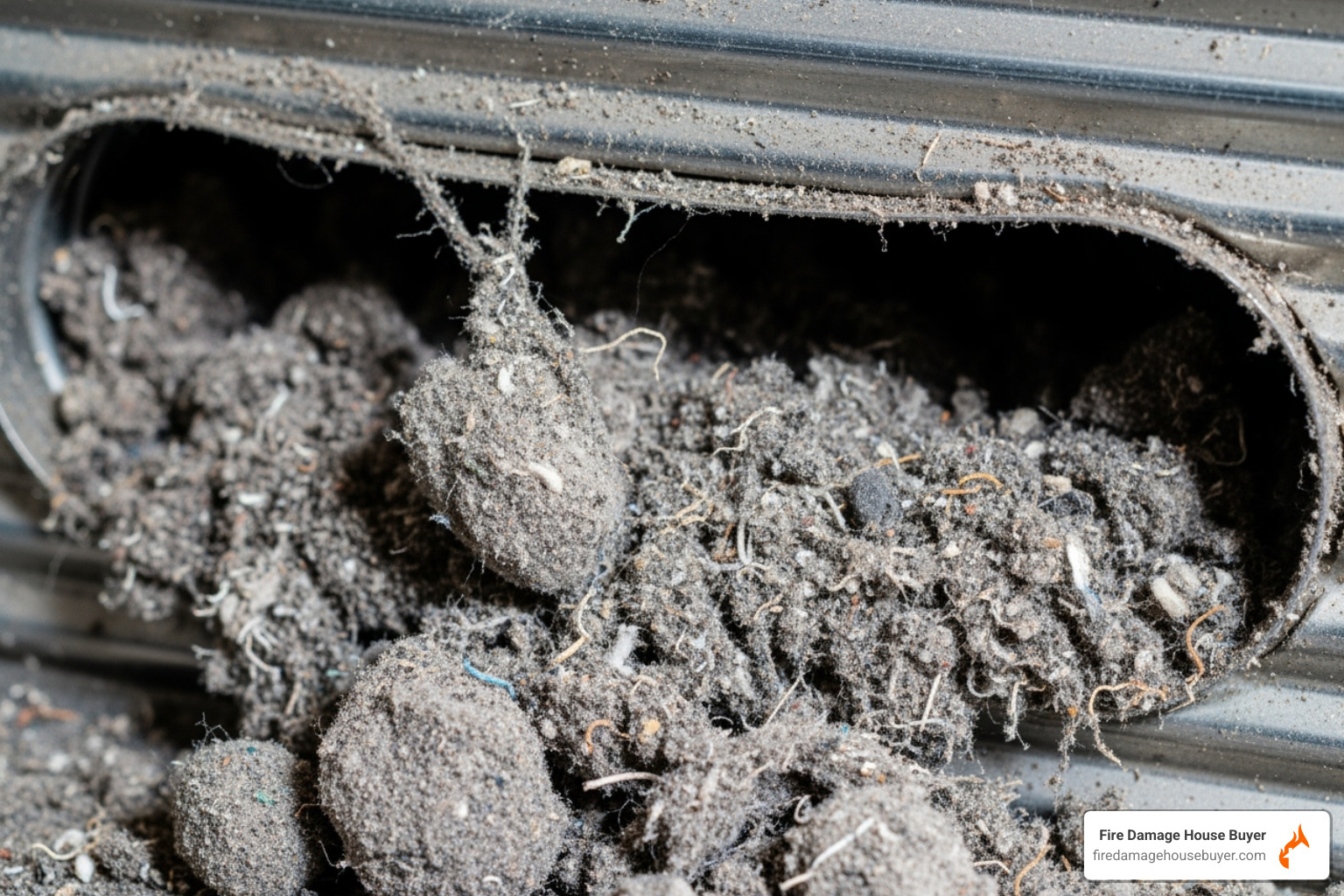Why Understanding Fire Causes Matters for Every Homeowner
Understanding what causes house fires is critical for every homeowner to prevent devastating losses and protect their family.
The top 5 causes of house fires are:
- Cooking incidents – 47.7% of all home fires
- Heating equipment – 9.3% of home fires
- Electrical malfunctions – 7.7% of home fires
- Unintentional/carelessness – 8.8% of home fires
- Smoking materials – 5% of home fires
The statistics are sobering: in 2020, there were nearly 332,000 home fires in the United States, causing 2,730 civilian deaths and billions in property damage. A home fire occurs every 87 seconds.
Behind these numbers are families facing smoke and water damage and the overwhelming task of rebuilding. Property losses from fires exceed $48 billion annually.
For those facing fire damage, the path forward is difficult. Restoration can cost $20,000 to $100,000+, but selling a fire-damaged property as-is offers a faster, less stressful solution.
I’m Daniel Cabrera, a real estate investor with 15 years of experience in distressed properties. I’ve helped hundreds of families steer the aftermath of fires by buying and selling over 275 fire-damaged homes. While prevention is key, it’s vital for homeowners to know all their options when disaster strikes.

The Top 5 Leading Causes of House Fires
To understand what causes house fires, we must examine the most common culprits. The following five categories account for the vast majority of home fires, injuries, and deaths. Let’s explore why they are so dangerous and how to prevent them.
1. Cooking Incidents
Statistically, the kitchen is the most common starting point for fires. Cooking is the leading cause of home fires in the U.S. (47.7%), the top cause of home fire injuries, and the second leading cause of home fire deaths.
The primary reason for kitchen fires is unattended cooking. A brief distraction is all it takes for a pot to boil over or a pan to ignite. Grease fires are particularly dangerous as they spread rapidly. High-heat cooking and leaving flammable items like towels near burners are also common mistakes. Cooking fires spike on holidays like Thanksgiving, which sees 2.3 times more fires than an average day due to increased distractions.
Prevention is key:
- Stay in the kitchen when frying, grilling, or broiling. Turn off the stove if you must leave.
- Keep a lid nearby to smother small grease fires. Never use water on a grease fire.
- Clean cooking surfaces regularly to prevent grease buildup.
- Move flammable items away from your stovetop.
- Use timers for baking or simmering and check food often.
For guidance on what to do after a kitchen fire, see our Post-Fire Recovery Resources. A little caution in the kitchen goes a long way!
2. Heating Equipment
Heating equipment is the second highest cause of home fires (9.3%), with risks peaking in winter.
So, what causes house fires involving heating equipment?
- Space heaters: While causing only 3% of heating fires, they are responsible for 41% of fatal heating fires, often because they are placed too close to flammable items like curtains or furniture.
- Furnaces: Malfunctioning or poorly maintained furnaces can overheat or leak fuel.
- Chimneys and creosote buildup: A buildup of creosote, a flammable tar-like substance, in chimneys can ignite and cause a dangerous fire.
- Fireplaces: Unattended embers, using flammable liquids, or lacking a proper screen can allow sparks to escape.
Prevention is crucial:
- The 3-foot rule: Keep flammable items at least three feet away from all heating equipment.
- Annual inspections: Have furnaces, water heaters, and chimneys professionally inspected and cleaned yearly.
- Proper ash disposal: Place ashes from fireplaces or wood stoves in a covered metal container outdoors until completely cool.
- Use space heaters safely: Choose models with auto shut-off features, plug them directly into a wall outlet, and turn them off when leaving the room or sleeping.
3. Electrical Malfunctions
Electrical systems are the third leading cause of home fires. An electrical fire starts every 10 minutes in the U.S.
What causes house fires related to electricity?
- Faulty wiring: Older homes may have outdated wiring unable to handle modern electrical loads. Warning signs include flickering lights, hot outlets, or a burning smell.
- Overloaded circuits: Plugging too many devices into one outlet or relying on extension cords can cause wires to overheat.
- Damaged cords: Worn, frayed, or pinched cords can expose live wires and spark a fire.
- Faulty appliances: Older or broken appliances can short circuit or overheat.
Prevention is vital:
- Professional inspections: Have a qualified electrician inspect the wiring in an older home.
- Avoid overloading outlets: Distribute your electrical load and unplug unused appliances.
- Inspect cords regularly: Replace damaged cords immediately and never run them under rugs.
- Use Arc Fault Circuit Interrupters (AFCIs): These devices detect dangerous electrical arcs and shut off power before a fire starts.
- Consider smart sensors: These devices monitor your electrical network for potential hazards.
Navigating insurance after an electrical fire can be complex. Our guide on Fire Damage Insurance Claims can help.
4. Smoking Materials
Though causing only 5% of home fires, smoking materials are the leading cause of civilian home fire deaths, highlighting the danger of careless smoking.
What causes house fires from smoking?
- Improperly extinguished cigarettes: Embers from a cigarette butt can ignite trash, mulch, or other flammable materials.
- Smoking when drowsy: Falling asleep with a lit cigarette is extremely dangerous, as it can smolder on bedding or furniture before igniting. The risk increases with alcohol or medication use.
- Ashes in flammable trash: Disposing of ashes in a plastic trash can can easily start a fire.
Prevention is paramount:
- Smoke outside: This is the safest practice.
- Use deep, sturdy ashtrays: Place them on a non-combustible surface.
- Douse butts with water: Ensure cigarettes are completely out by soaking them in water or sand before disposal.
- Stay alert: Never smoke in bed or when drowsy, drinking, or on certain medications.
- Never smoke near medical oxygen.
The U.S. Fire Administration strongly recommends these practices to prevent smoking-related fires.
5. Candles and Open Flames
Candles are a significant fire hazard, causing about 20 home fires daily, resulting in extensive property damage, injuries, and deaths each year.

What causes house fires from candles and other open flames?
- Leaving candles unattended: This is the most common and dangerous mistake.
- Placing near flammable materials: Curtains, books, decorations, and bedding can easily ignite if a candle is too close.
- Children or pets: A curious child or pet can easily knock over a burning candle.
- Improper holders: Unstable or flammable holders increase the fire risk.
Prevention for safer ambiance:
- Never leave unattended: Extinguish all candles before leaving a room or sleeping.
- Keep away from combustibles: Maintain at least a one-foot clearance from anything flammable.
- Use sturdy, non-combustible holders.
- Trim wicks to one-quarter inch before each use to control flame height.
- Place out of reach of children and pets.
- Consider flameless alternatives: LED candles provide ambiance without the risk.
The Aftermath: Navigating Recovery After a Fire
After a fire, the real challenge begins. While understanding what causes house fires is key for prevention, navigating the aftermath is complex and overwhelming. Here’s what to expect.
The True Cost of Fire Damage
The flames are just the beginning. Beyond burn damage, your home faces a triple threat:
- Smoke and Soot: Corrosive residues infiltrate every surface, causing ongoing damage and leaving a stubborn, expensive-to-remove odor.
- Water Damage: Water from firefighting efforts leads to potential mold, weakened drywall, and ruined flooring.
- Structural Damage: Heat can weaken support beams and compromise your home’s foundation, creating hidden dangers.
Hidden costs also pile up, including temporary housing, replacing personal belongings, and lost income. Annually, property losses from fires exceed $48 billion.
To understand your property’s value after a fire, consult our guide on How to Price a Fire Damaged House.
The Difficult Path of Fire Damage Restoration
Fire damage restoration is not a quick fix. The process is long, expensive, and emotionally draining. It involves:
- Damage assessment and securing the property.
- Water extraction and drying, which can take weeks.
- Soot and smoke removal using specialized equipment.
- Cleaning and sanitizing all salvageable contents.
- Structural repairs, which may involve rebuilding sections of your home.
- Full renovation and finishing.
This journey can take over a year and often involves unexpected costs. You’ll have to manage insurance adjusters, contractors, and inspectors, turning recovery into a full-time job. For help navigating this process, explore our Fire Damage Resources.
Is Restoration Always the Best Choice?
Given the challenges, it’s important to ask if restoration is the right path for you.
- Timeline: Restoration can take 3-12+ months. Selling your home as-is to a cash buyer can take just 2-3 weeks.
- Cost: Restoration costs range from $25,000 to $150,000+. Even with insurance, you’ll face deductibles and uncovered expenses.
- Stress: Managing a restoration project is a stressful, full-time job involving contractors and insurance disputes while you’re recovering from trauma.
Selling as-is provides a clean break. It offers immediate cash to move forward without the delays, uncertainty, and emotional toll of rebuilding. Many families find that selling gives them the freedom to start fresh, away from the daily reminder of the fire.
What Causes House Fires and How to Be Prepared
Beyond the top five culprits, there are other common hazards that contribute to what causes house fires in our homes. Being aware of these additional risks can further strengthen your defense against fire and keep your loved ones safe.
Other Common Fire Hazards in Your Home
Beyond the top five, other common hazards contribute to what causes house fires.

- Clothes Dryers: Lint buildup is highly flammable and causes over 15,000 fires annually. Clean the lint trap before every load and have the dryer vent professionally cleaned once a year.
- Flammable Liquids: Gasoline, paint thinners, and solvents are serious risks. Store them in approved, sealed containers in a cool, well-ventilated area away from heat sources.
- Outdoor Fires: Grills and fire pits must be kept a safe distance from your house, deck, and any combustible materials. Never leave them unattended and dispose of hot coals properly.
- Children Playing with Fire: A child’s curiosity about matches or lighters can be devastating. Keep all fire-starting materials out of reach and educate children about fire safety.
What causes house fires and how can they be prevented?
Most fires are preventable with awareness and diligence. Here is a summary of key prevention tips:
- Watch cooking food and never leave it unattended.
- Clean dryer lint traps before every use.
- Don’t overload electrical circuits.
- Keep heaters clear with a 3-foot safety zone.
- Extinguish smoking materials properly, preferably outside.
- Use candles safely and never leave them unattended.
- Store flammable liquids in approved containers away from heat.
- Educate children on fire safety and keep matches out of reach.
- Have and practice an escape plan with your family twice a year. Everyone should know two ways out of every room.
The Lifesaving Importance of Alarms and Extinguishers
Even with perfect prevention, you need the right safety equipment.
Smoke alarms are your first line of defense. Three out of five home fire deaths occur in homes without working alarms. Per official regulations, you must install alarms on every level, inside each bedroom, and outside sleeping areas. Test them monthly, replace batteries annually, and replace the entire unit every 10 years.
Beyond alarms, fire extinguishers are your active defense. Keep an accessible ABC-rated extinguisher on each level, especially in the kitchen and garage. It’s crucial to learn how to use them properly – remember the simple PASS method: Pull the pin, Aim at the base of the fire, Squeeze the handle, and Sweep from side to side. An extinguisher can contain a small fire, buying you precious time to escape.
Frequently Asked Questions about House Fires
Even after learning all about what causes house fires and how to prevent them, it’s natural to have lingering questions. We often hear similar inquiries from homeowners trying to understand these devastating events and how to protect their properties. Let’s tackle some of the most common ones.
What is the single most common cause of a house fire?
Without a doubt, cooking is the number one cause of house fires, accounting for nearly half (47.7%) of all residential fires. The most common reason is unattended cooking. Stepping away from the stove, even for a moment, can allow a grease fire or an overheating pan to ignite. This simple distraction is why kitchens are the most frequent starting point for fires.
Where in the home do most fires start?
The kitchen is the leading area of origin for residential fires, accounting for 44% of all incidents due to its concentration of heat, flames, and appliances.
Other common starting points include:
- Bedrooms: From careless smoking or electrical faults.
- Living Rooms: From heating equipment or candles.
- Utility Rooms: From appliances like clothes dryers with lint buildup.
What day of the year has the most house fires?
Thanksgiving Day consistently has the most home cooking fires of any day of the year. The combination of elaborate meals, multiple dishes cooking at once, guest distractions, and a festive atmosphere creates a perfect storm for unattended cooking. This is a powerful reminder to be extra vigilant in the kitchen during holidays.
Conclusion: Your Options After a House Fire
Understanding what causes house fires is the most crucial step in protecting your home. We hope this guide has equipped you with practical tips for a safer environment.
However, fires can still happen, and the aftermath is challenging. The recovery process is expensive, time-consuming, and emotionally draining, leaving homeowners feeling overwhelmed.
If you’re dealing with a fire-damaged property, restoration isn’t your only choice. Rebuilding may not be feasible or desirable when you’re ready for a fresh start.
This is where Fire Damage House Buyer steps in. We offer a simple, fast solution: we purchase your home as-is for cash. You don’t have to make a single repair. This allows you to avoid the stress and expense of restoration, skip frustrating insurance battles, and move on with your life.
We buy houses in any condition, across the country. Our goal is to provide a hassle-free way to sell your fire-damaged house with no commissions or hidden fees—just a fair cash offer.
If you want to avoid the complexities of restoration, let us help you start a new chapter. Learn how to Sell Fire Damaged House without the hassle.



